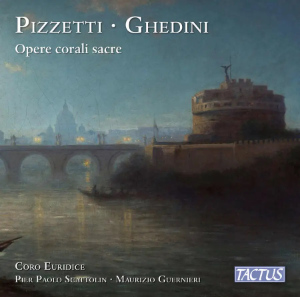
Ildebrando Pizzetti (1880-1968)
Messa di Requiem
Giorgio Ghedini (1892-1965)
Ave verum corpus
Canti sacri
Mottetti per un tempo di penitenza
Responsori per il Sabato Santo
Coro Euridice/Pier Paolo Scattolin (Pizzetti), Maurizio Guernieri (Ghedini)
rec. 2022, Church of San Girolamo della Certosa, Bologna, Italy
Tactus TC880005 [56]
The Generation of the 1880s, notably Ottorino Respighi, Alfredo Casella, Gian Francesco Malipiero and Ildebrando Pizzetti, were a group of Italian composers who wanted to free Italian music from the domination of opera. This does not mean that they wrote no operas. They simply wished to create in other musical forms, too.
In choral music, one of this group’s best-known works is Pizzetti’s Messa di Requiem from 1922-1923. It was commissioned as a memorial to King Umberto I, who had been assassinated in 1900. Pizzetti later said that without the commission he would never thought of writing a Requiem. Even so, his feelings about World War I and the death of his first wife in 1920 may have contributed to the solemnity and austerity of the work. It is scored for five-part chorus a cappella. Pizzetti eschews the usually included Domine Jesu Christe, Lux Aeterna and In paradisum, so the work consists of Kyrie, Dies Irae, Sanctus, Agnus Dei and Libera me.
The opening Requiem aeternum is full of emotion, but – as frequently with Pizzetti – restrained and lyrical at the same time. The lyricism extends to the contrapuntal elements, almost like Mahler’s middle symphonies. In many settings of the Requiem Mass, the largest section is the Dies Irae, as in the Berlioz and Verdi works of this type. This is also true of Pizzetti’s work, but his Dies Irae is not a gigantic evocation of the Day of Judgement, but a plea for salvation, mostly built around the words “salva me” (save or preserve me).
Pizzetti pays tribute to Ambrosian chant in the Dies Irae, but the Sanctus and Benedictus hark back to 17th century Venice in its division of the choir into three sections. The music is full of joyous bell-like effects balanced by almost acerbic counterpoint, an example of Pizzetti at his most characteristic. The concluding Hosanna is most imaginative. Pizzetti halves his choir and reduces it from five parts to four in the Agnus Dei, quite simple and full of concentrated emotion, rather like some Randall Thompson’s unaccompanied works. More modern is the Libera me, with its continuing tread in the lower voices and more confident upper voices. The work ends ambiguously.
By the time Giorgio Ghedini began his career, composing in a variety of genres was no longer a noteworthy phenomenon in Italy. He may be best remembered for his orchestral works, his Canti Sacri (sacred songs), and numerous choral works, large and small, several of which appear on this disc. The choral works blend Ghedini’s natural songfulness with a dissonant component, and occasionally an operatic sense of drama. These qualities are most evident in the Ave verum corpus and the 2 Mottetti per un tempo di penitenza. The 3 Responsori per il Sabato Santo are sadder, almost tragic, while the 2 Canti sacri show Ghedini’s gentler side, though dissonance is still present. All these works demonstrate the utmost sincerity.
There are really two ensembles on this disc: the full Coro Euridice under Pier Paolo Scattolin in Pizzetti’s Requiem, and the Coro’s chamber choir under Maurizio Guernieri in Ghedini’s works. The acoustics of the Church of San Girolamo della Certosa lend themselves better to the latter. Maurizio Guernieri brings out Ghedini’s varied compositional elements with great attention to the part-writing and the generally serious tone of the works. A mighty work like the Messa di Requiem requires a strong handfrom the conductor, and Pier Paolo Scattolin provides this. Overall, a fine disc, notably Ghedini’s works.
William Kreindler
Buying this recording via a link below generates revenue for MWI, which helps the site remain free


















